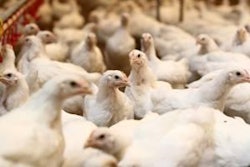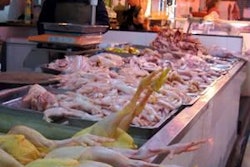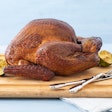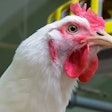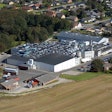Down a long stretch of highway, deep in the heart of Texas, there stands a prominent silhouette against the Lone Star sky: the Cargill feedmill at Seguin, a plant which counts among its honors being named last year's Feed Mill of the Year Runner Up. And where once chickens, horses, cows and pigs were the main beasts catered to, this innovative operation is striving to meet the nutritional needs of a whole new breed.
Wildlife. Not a bucket of birdseed. Wildlife on a wild scale. The feedmill at Seguin caters to deer, elk...even some giraffe and zebra. It's a sign of the times, say management. And in this part of Texas, the signs for the animal-feed industry are pointing increasingly away from traditional livestock and toward animals not kept for meat, milk or performance, but for sport and enjoyment.
Unlocking genetic potential
"We've learned a whole lot about deer nutrition," points out John Windwehen, North American strategic account leader, sporting and wildlife, Cargill. "People used to use whole corn to attract deer because they enjoyed watching them. But we've learned so much more about their nutritional needs since then." Like domesticated livestock, where nutritionists have learned that animals have very specific nutritional needs, the Seguin plant's Deer and Game Specialist Louis Etzel says eventually it became apparent that by matching a deer's actual nutritional needs — and not just tossing them some corn — you unlocked the true genetic potential of the animal, just as the animal agriculture industry had done with farm species generations before it.
"I could take you to many ranches where we used to work cattle. But cattle feedlots are now filled with deer blinds," says Etzel.
Adds Windwehen, "Cattle can eat grass, but deer eat brush, which is especially attractive in the Deep South, where drought has made it hard to graze cattle on grass. They've found they can actually make some money."
Etzel says a large segment of the deer enthusiasts come from absentee land owners who originally bought the land for recreational purposes. He says a lot of acres in the county have been bought up strictly for hunting.
"Back in the 1970s," recalls Windwehen, "deer feeding began evolving and slowly unlocked the deer's genetic potential. People used corn as a nutritional supplement with wild deer and as an attractant, although this was not meeting the nutritional needs of the animal. But this was a wild animal. How do we get it to come to a feeder for a feed supplement?"
The management team at Seguin points to a number of things learned about deer nutrition over the past few decades. Deer can become very sick, very quickly, simply because they pick up a certain element in their environment. Deer fed nothing but corn can suffer ill health as well.
So who is this new customer targeted by Cargill's exotic feed line, known as "Record Rack?" The management team at Seguin says the target customers generally fall into just a handful of categories: wildlife enthusiasts feeding deer to observe them, sportsman/hunters who feed deer to ensure a plentiful population of deer for sport, professional game managers who raise deer for a number of purposes, and the breeder who is focused on enhancing genetics so that improved animals can be turned back out into the wild to improve the species.
Windwehen admits there is some negative connotation that "we feed them and shoot them." But he says such perceptions are not fair. "Yes, we hunt. But many sportsmen get as much enjoyment out of watching these animals and just letting them go as we do shooting them." He sees sportsmen who fall into their market segment as the original conservationists, educating themselves about the genetics and nutritional needs of the deer and letting deer in the wild mature before harvesting them.
He says the approach to deer as sport in Texas may differ from other areas of the US. In the north, for example, individual landowners own relatively small parcels of land. But in Texas, land owners are dealing with parcels of 50,000 to 100,000 acres where deer can be left to roam behind a high fence and sportsmen can utilize seasonal leases on the land. Still, not every deer enthusiast in Texas has 10,000 acres. But Windwehen says that a lot of the deer being raised nationwide, deer that can be improved with more targeted nutrition, can thrive even on 100 acres. He has heard about some areas where neighbors are going together to manage 1,000 acres, establishing rules for hunting, and developing nutritional and genetics improvement goals and maintaining a deer herd. While there are large, commercial operations that are customers, Cargill's Seguin plant still sells a majority of its Record Rack line to free-ranging deer on land with low fences where improvements in nutrition are harder to control. They also add that every state has its own laws addressing the raising and supplementation of deer.
Even with targeted nutrition, other factors — such as harsh winters —can raise havoc on a deer herd. Wildlife enthusiasts who rely only on corn to supplement deer are more likely doing the animal harm by not providing them a proper diet.
Etzel says he is amazed at how the breakdown of volume of feed sold by species has changed in the past five years. Windwehen believes that within the feed market, deer feeding is quickly evolving into a viable niche market. At the Seguin plant, that segment now represents about 40% of the feedmill's sales by volume. "That is big. Even for this area, it's big." Overall in Texas, deer will represent about 15% of Cargill's total volume in Texas. That's a trend he sees replicating itself across the nation. While the Whitetail is king in Texas, elk are the popular exotic in Montana and states out west, along with mule deer and exotics. Breeding such animals is truly big business: it's no longer unusual to have a straw of semen from a prize buck go for $5,000. Top breeder bucks can fetch up to half a million dollars at auction.
So what are the keys to meeting the diet needs of Whitetail? Windwehen says pellet quality is key. One of the things they have learned is how to get deer to come to a feeder. "You have to make a great quality pellet, then screen it and deliver it without losing that quality," he says.
Plant manager Paul Yandle adds that based on the Pellet Durability Index (PDI) developed at Kansas State, they use a minimum of 97% for pellets going into their Record Rack line.
Cargill has invested considerable research and knowledge into identifying the key ingredients to go into the pellet, a formula it won't change despite shifting commodity prices. One goal of Cargill's proprietary ingredients is to help the deer to better digest the fibrous material found in its environment and derive more energy from it. The management team at Seguin says that while a lot of research has been done, there are still a lot of things they do not know regarding nutritional needs of deer and other exotics. "In fact, a lot of the nutritional work used was done as goat research," notes Etzel.
Cargill has partnered with the Caesar Kleberg Wildlife Institution in Kingsville, Texas, on cooperative nutrition research. "They've done a great job of researching whitetail and other wildlife," notes Windwehen.
.jpg?auto=format%2Ccompress&crop=faces&fit=crop&h=48&q=70&w=48)


